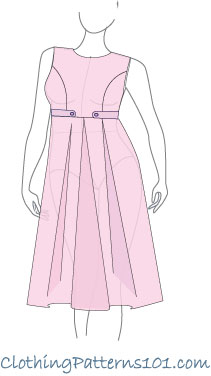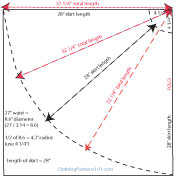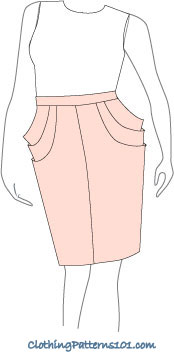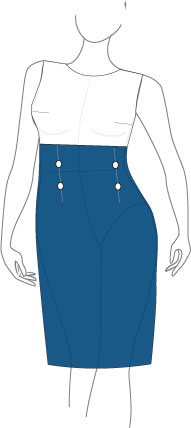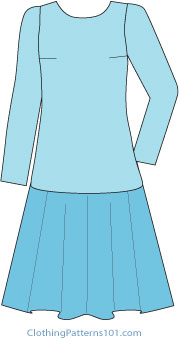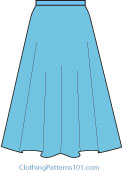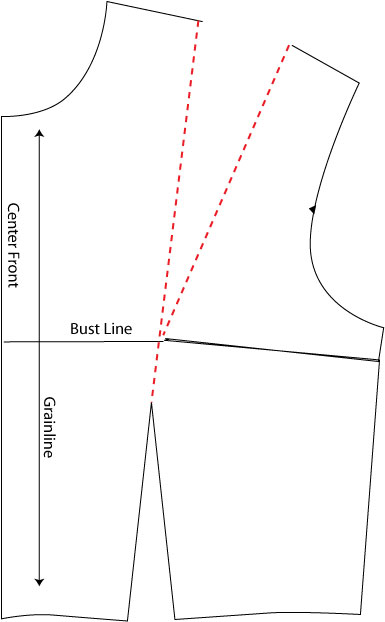- Clothing Patterns 101
- Skirts and Dresses
- High Waist Dress
How to Draft a High Waist Dress with Skirt Pleats
A high-waist dress with pleats in the skirt is a "fit and flare" style that is great at hiding a thick waistline or larger belly!
That describes me to a "T" - I love the look of a fit and flare dress, but it doesn't look good on me. I have thick waist, large belly, and a rear end to match. I do not have hips! So the flare of the skirt could give me shape, but if it fits closely at the waist, it just emphasizes my "larger bits".
|
The dress has several lovely features - the high waistline, Princess seams for bust shaping, and soft inverted box pleats in the skirt. It looks great in a soft (but not too fluid) fabric. If the fabric is too drape-y, the pleats won't hang well. If it's fairly stiff, the skirt may flare more than you like - but if a wider flare is what you want, you can certainly use a firmer fabric! |
Drafting the High Waist Dress with Pleated Skirt
|
As with any dress, you start by combining the bodice and skirt of the dress block into one piece. For the dress we're making, the center front will eventually be cut on the fold - but it's easier to draft one side only. ***It's a good idea to make a one-piece dress block if you sew a lot of dresses. Once you have both a bodice/skirt block and a one-piece dress block, you won't have to repeat these steps with every dress. |
|
Decide where you want the raised waistline to sit on your body. I've drawn it fairly high, but it should not be right below the bust. This is a high waist, not Empire. I'd recommend somewhere right between the natural waist and the underbust - probably 3" - 4" above your natural waist. However, you can raise it as much or as little as you like. If, unlike me, you actually have a waistline, you could even draft this with a natural waist! It's a very different look, but if you have a figure that is somewhat more "hour-glass", it would look great as a conventional fit and flare dress. |
Next, prepare the pattern for the Princess seam at the bust, and for the pleats in the skirt. Follow the red dashed lines in the sketch above, on the right.
Cut the traced pattern apart along the red dashed lines.
|
On the upper/bodice section of the pattern, close the side bust dart, opening a dart at the armhole. The red dashed line at right indicates where the Princess seam will end, and it will line up with the front of the skirt pleat. Using the lower section for the skirt, add a 4” extension at the front for 1/2 the inverted box pleat at center front. (see the red dashed lines at Center Front). I've drawn this to be cut on the fold, so the full pleat will be revealed after the skirt is cut and unfolded. (I've drawn the final pattern, below, without the "cut on fold" instructions - the paper pattern shows the full skirt and bodice). Then, midway between the original center front and the side seam, cut the pattern vertically and spread 8”. (see red dashed lines in center of skirt panel). This is the inverted box pleat that will appear on each side of center front. I have also straightened the side seam a bit. The sheath dress/one-piece dress block has some shaping at the waist, which is not necessary in this style. |
|
Each side of the inverted box pleat will be 2” deep, with a 4” total underlay. The TOTAL pleat (the 2 pleats that face each other) will have and 8” underlay. That’s the reason for the 8” spread. |
Your final pattern, showing both sides of the front dress (fold line and markings removed) will look like the one below. You can keep the pattern with the center front cut on the fold of the fabric, if you prefer, but this shows how the full dress will ultimately look.
The bodice has Princess seams for bust shape.
The skirt has 3 inverted box pleats - one at center front, and one at each side of center front, each of which line up with the Princess seams.
REMEMBER TO MAKE THE SAME CHANGES ON THE BACK BODICE AND SKIRT for balance and consistency. The Princess seams are not necessary at the back bodice, but you can add curved seams as a design feature if you'd like. They do not serve a purpose for fit at the upper back.
And that's your dress!
I think the style is flattering on virtually anyone. Experiment with the bodice in muslin to determine the best position of the waist seam on you, and you'll have a lovely yet comfortable dress that you can dress up or down!
More Skirts and Dresses
Return to Clothing Patterns 101 Home Page
ClothingPatterns101.com does not sell the personal information of its users to anyone, ever.

